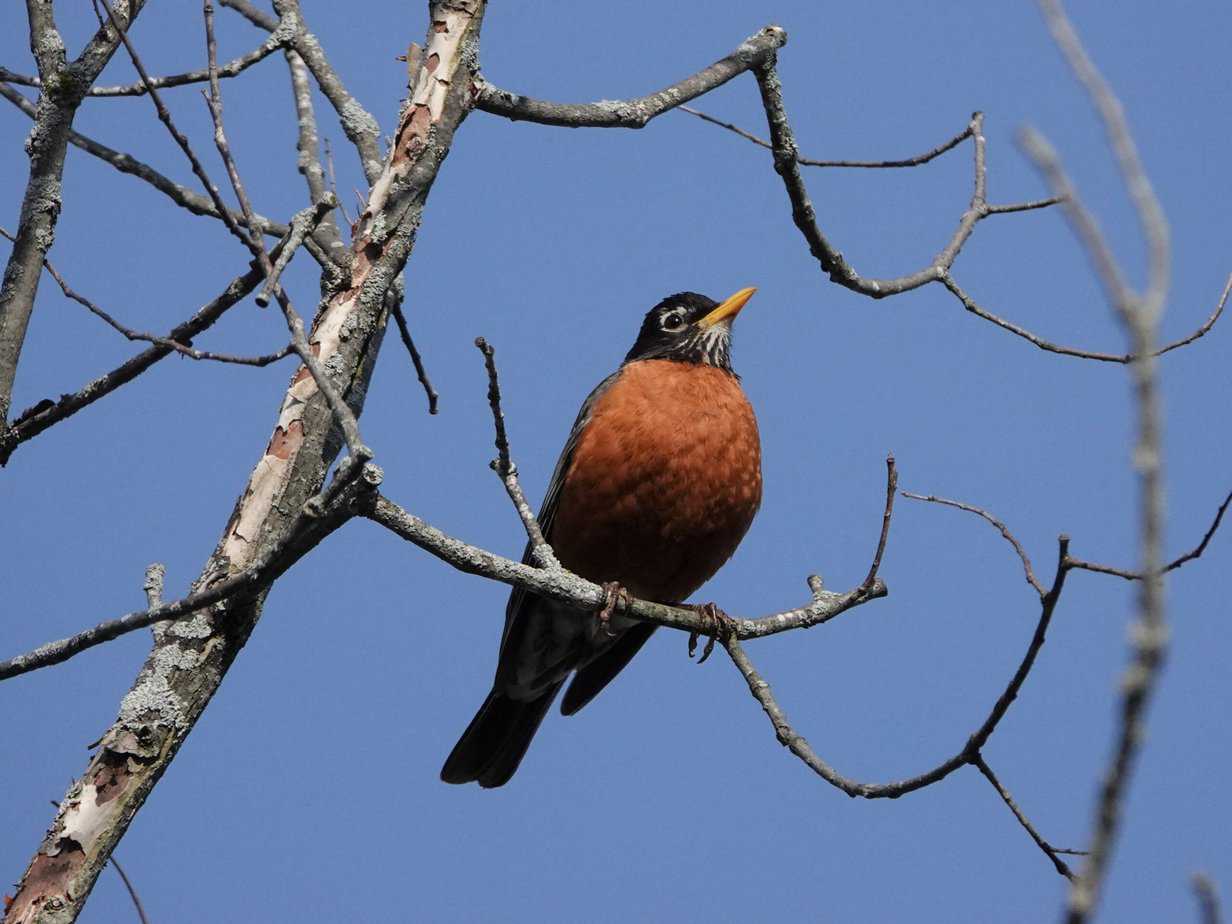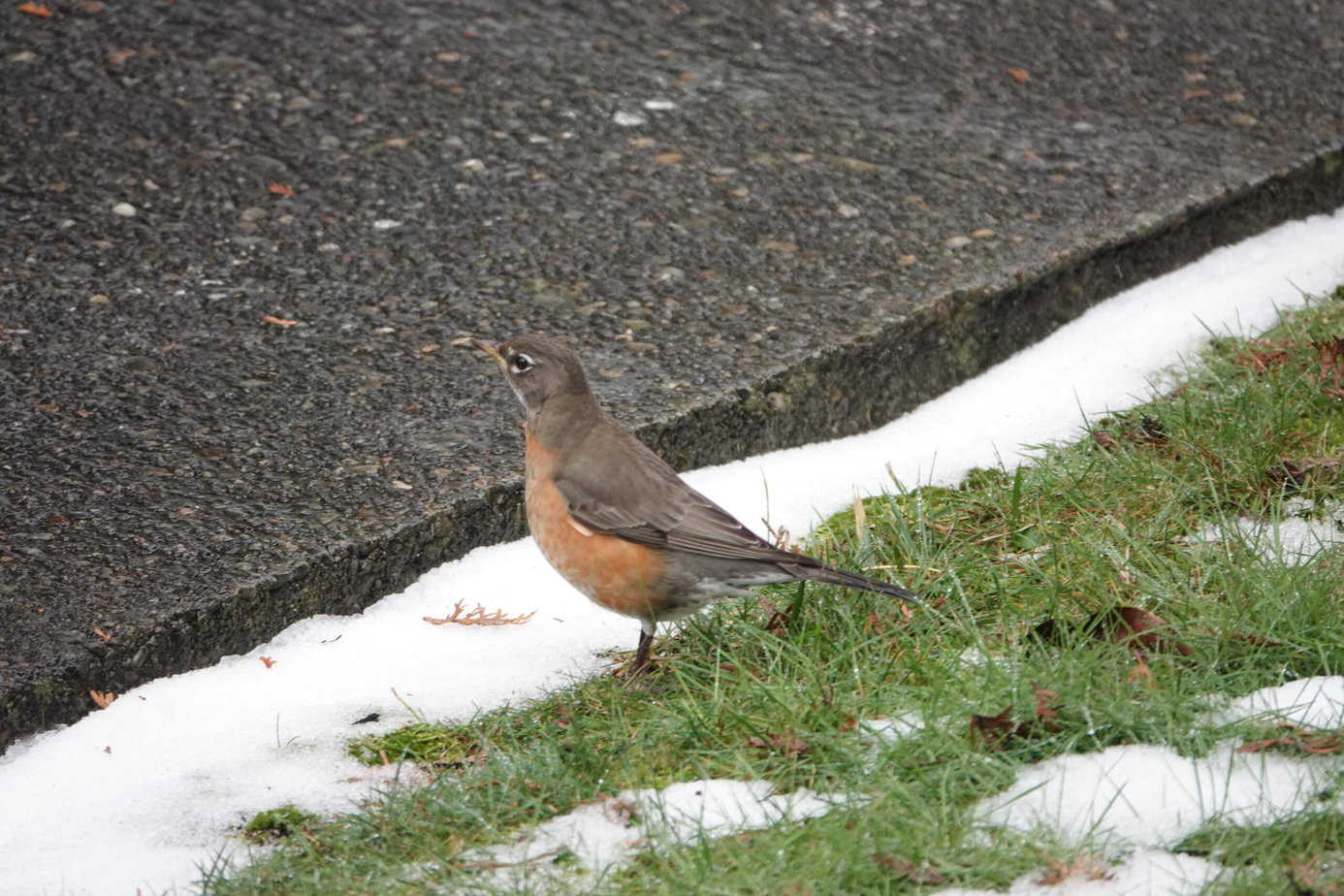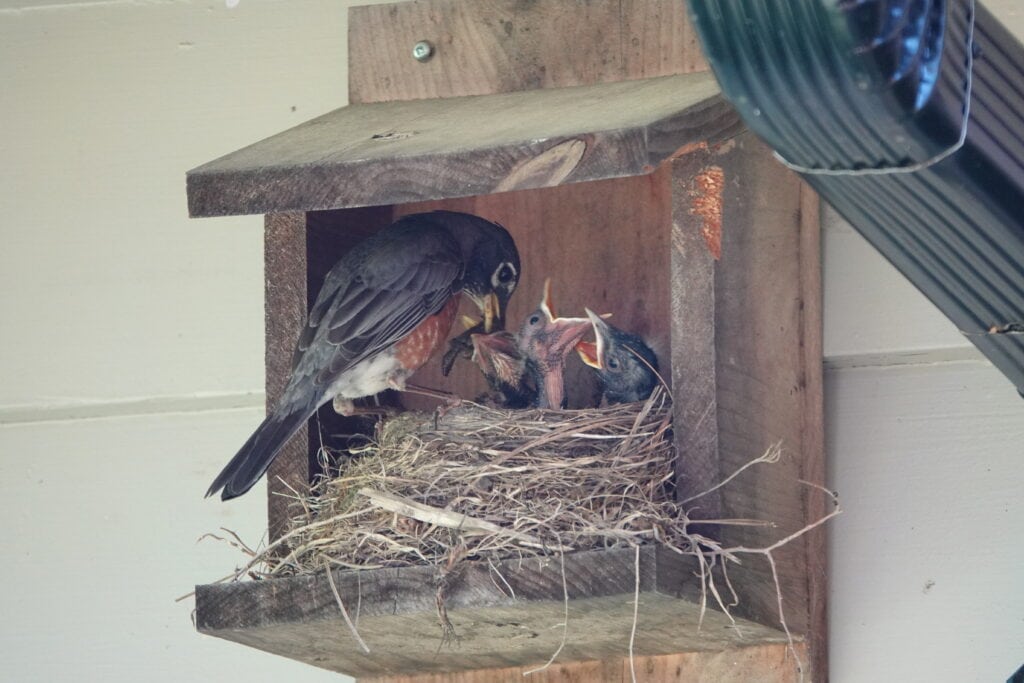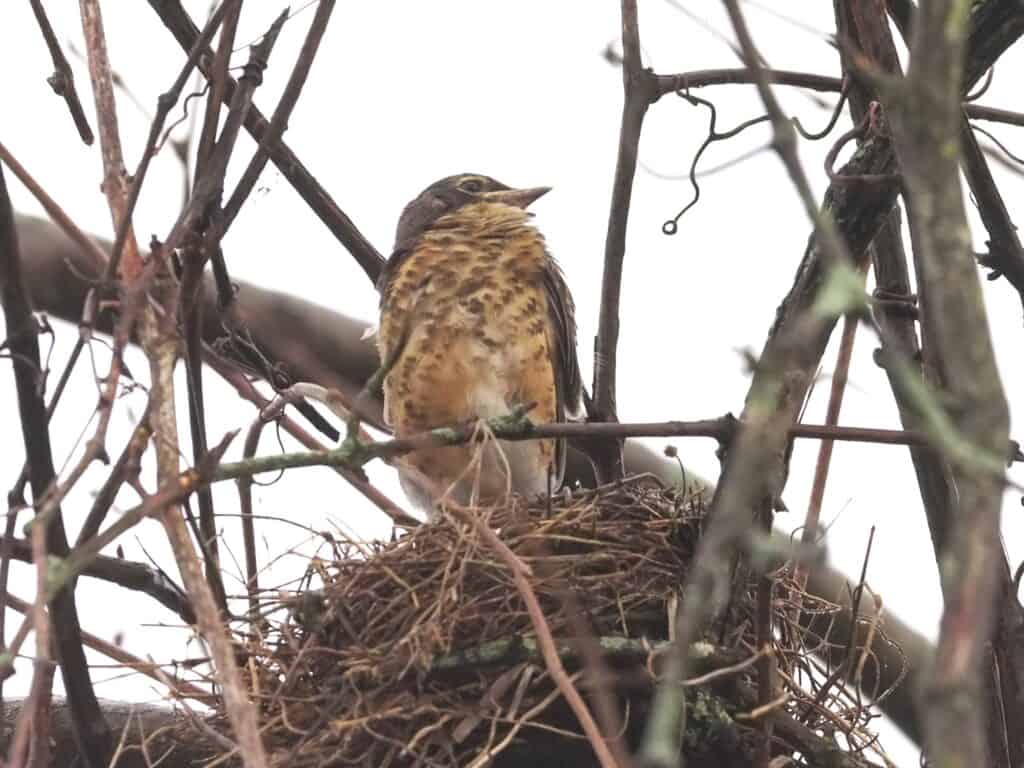Nesting season is a reminder to keep cats indoors
Peterborough Examiner – April 28, 2023 – by Drew Monkman
It’s hard not to have a special fondness for robins. Unlike most other birds, they treat us to intimate views of their family lives and provide a rewarding connection to backyard nature. A pair have once again set up house on a nesting platform on the back of our garage. Every time we exit or enter through our back door, the indignant female flies off the nest voicing her annoyance in no uncertain terms. With any luck, however, she and her mate will successfully raise a brood like they did last year.
With a bit of practice, distinguishing between the sexes is easy. The male robin has a black head that contrasts sharply with the gray back. In comparison, the female appears duller overall with little difference between the head and back. Juvenile birds have the coloration of the female, but the breast is spotted.


Singing
Robins are the first birds to sing reveille in the morning, usually starting about an hour before dawn. The male robin delivers a musical “cheerily…cheer-up…cheerio” series of clear, short, whistled phrases that continually rise and fall. Early in the breeding season, dawn singing serves primarily to attract a female.
Once paired up, the male will continue to sing at both dawn and dusk to tell other males to stay clear of his mate and nesting territory. He is essentially saying, “This piece of real estate and female are already taken, so back-off, buddy.” Singing is energy-intensive, and the polar opposite of the relaxed, carefree whistling we humans engage in. However, it is still a more efficient use of energy than fighting or chasing away intruders – behaviours that tend to be a last resort.
Nest building
Robins usually begin nesting in early April. They will often return to the same territory year after year, albeit with a different mate. Once the female (surprise!) has chosen a nesting site, typically on horizontal branches or building ledges and recesses, the male brings her nesting material. She’ll have nothing to do with him actually building the nest, however.
The nest is composed of dead grass and twigs, cemented together with mud from earthworm castings or from the edge of a puddle. The building technique is ingenious. The female drops grass on top of a layer of mud and moulds it into shape by sitting, squirming, pushing with the wrist of the wings, and stamping with her feet. She then turns several degrees and repeats the process, eventually making several complete rotations. The whole endeavour takes two to six days.
As a rule, the same nest only serves for one brood. This is partly because a used nest is often home to harmful parasites. You can therefore take the old nest down once the young have departed. If your backyard robins have chosen a problematic location, remove the nest before it’s completed. If the nest should fall to the ground, you can put it back where it was – contents and all. The parents will most likely return.
Family life
The female robin generally lays four blue eggs– one per day – and takes full responsibility for incubation, a process that lasts about two weeks. In order to efficiently transfer body heat to the eggs, all female birds have a brood patch. This is an area of the belly where the feathers are automatically shed. The mother presses this warm, bare patch against the eggs or young nestlings.
Both parents bring food to the nest for the babies, stuffing them with high-protein earthworms six or seven times an hour. It’s no wonder the babies balloon to ten times their birth weight after only ten days.
Baby robins instinctively know to sit low and still when the parents are away, to pop up and open wide when they return, and to poop immediately after swallowing food. They actually produce a kind of self-generated disposable diaper. Their poop and urine emerge together in a bag called a fecal sac. It is made of thick, strong mucous. This allows the parent to pick the bag up and drop it far from the nest.
After the babies are about a week old, space is at a premium. At this point, the mother no longer sits on the nest at night, but moves to a nearby tree branch to sleep. To stay warm, the babies simply snuggle together.
The young are fully feathered 10 days after hatching and head out into the world at about 14 days. Birds are usually considered to be “fledged” once they leave the nest, even if they can’t yet fly. Fledglings are still dependent upon parental care and feeding. The male takes responsibility for their care and will continue to feed them for up to three weeks. In the meantime, the female will usually lay another batch of eggs, most often in a new nest. Some robin pairs will nest up to three times in a season.
Free-roaming cats
If you find a fledgling robin, or any other bird species for that matter, resist the urge to pick it up. Most babies on the ground are not orphans. If the fledgling is clearly in harm’s way, you can place it in a nearby sheltered spot. A parent will quickly find it. Birds have a poor sense of smell, so your scent is not a problem.
Sadly, many robin eggs, babies and fledglings fall prey to predators. The most common culprits are crows, grackles, and cats. Always keep your cat indoors or in an enclosure and encourage your neighbours to do the same. Remember that Peterborough has a by-law stating, “Owners of cats must not permit their cats to be off their own property, or on the property of anyone else without their consent.”
Migrating songbirds from the tropics – many of which are in serious decline – are also a favourite target of cats. The oriole, warbler or tanager that shows up in your yard is tired, hungry, and unfamiliar with its surroundings. This makes it perfect prey for a cunning, free-roaming feline.
Feral or unowned cats are responsible for about two-thirds of all cat-killed birds. This brings me to the controversial topic of Trap-Neuter-Return (TNR) which is the practice of capturing unowned cats so they can be vaccinated, spayed or neutered, and re-released into the wild. You might think that this approach would reduce the number of free-ranging cats over time. However, according to the Cornell Lab of Ornithology – one of the world’s most highly respected bird research organizations – studies have shown TNR to be ineffective. Among other unintended results, it may actually increase the size of feral cat colonies. For details, go to https://tinyurl.com/er2wmnuk
If we weren’t in the midst of Earth’s sixth extinction crisis, predation by cats wouldn’t be such a crucial issue. But we are. Crunch time is upon us, and difficult, sometimes gut-wrenching decisions have to be made. It’s estimated that North American bird populations have plummeted by nearly 30% since 1970. Habitat loss, cats, and window collisions are the three biggest causes.
I believe that cats need to be removed from feral communities so they can be adopted, placed in a cat sanctuary or, as a last resort, euthanized. It’s not easy to say this because I, too, love cats. However, by letting them roam freely or by supporting TNR, we are placing a higher value on the freedom of cats than on the lives of our native birds and other animals. We are also contributing to a world where biodiversity could soon be reduced to little more than domesticated animals and human-adapted urban wildlife like raccoons and pigeons. Is this the kind of natural world we want for our children and grandchildren?
CLIMATE CHAOS UPDATE
Carbon Dioxide: Atmospheric CO2 levels for the week ending April 22 reached the highest weekly average in HUMAN HISTORY. Readings registered 423.65 parts per million (ppm) compared to 420.65 ppm one year ago. Rising CO2 means more climate catastrophes ahead.
Upcoming events: On May 8 from 7 – 8 pm, Dr. Anne Pasek, an Assistant Professor in the Department of Cultural Studies and the School of the Environment at Trent University, will be the guest speaker at 4RG Meets. Her talk is entitled “Why Diversity is an Asset to the Climate Movement”. Register for this Zoom event at https://tinyurl.com/49n535ws or email 4RGmeets@gmail.com

